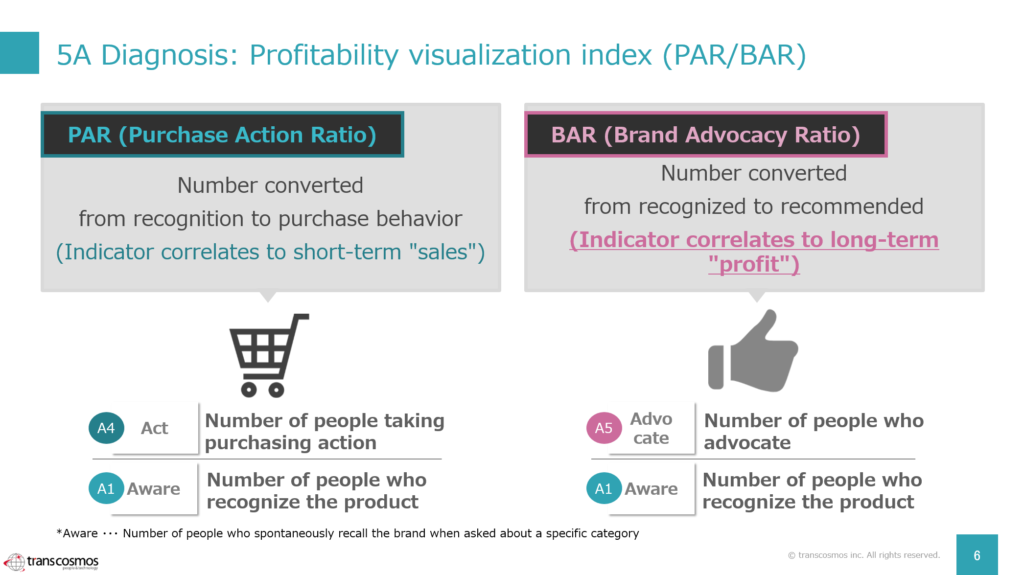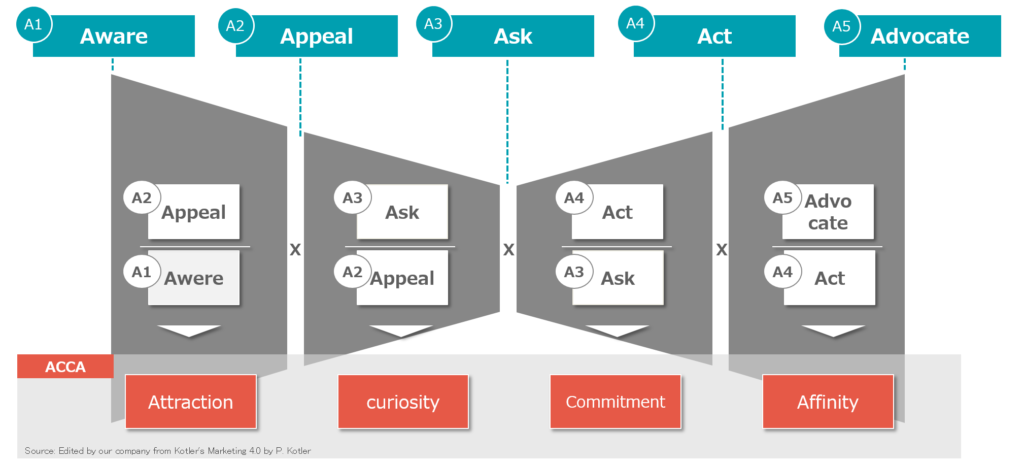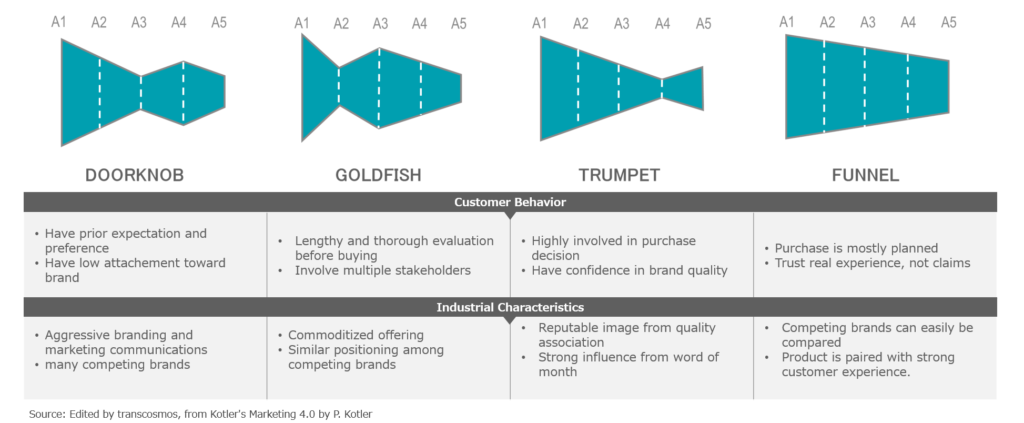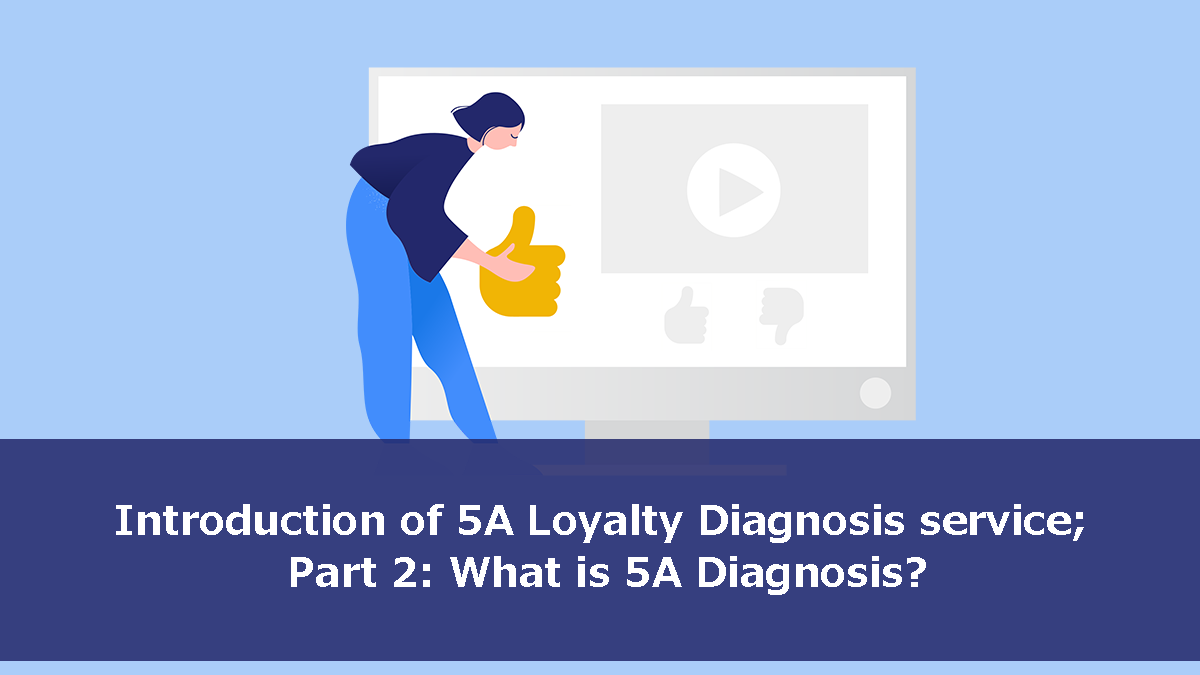This article introduces the “5ALoyalty Diagnosis” service, which allows you to engage in loyalty marketing based on the original indicators proposed by Philip Kotler, the “father of modern marketing”.
This is a five-part series on why loyalty marketing is needed now, and the purpose and benefits of the service. In this second series, we will explain the 5A Diagnosis, which is the basis of the “5A Loyalty Diagnosis”.

Contents
What is “5A”?
As I mentioned in my previous article, “5A Loyalty Diagnosis” consists of three diagnoses: 5A Diagnosis, CX Diagnosis, and Perception Diagnosis. The second article will explain what a 5A diagnosis can do and what indicators and patterns it can show. The 5As advocated by Philip Kotler is divided into the five-step process of Aware, Appeal, Ask, Act, and Advocate, respectively. The 5A diagnosis can visualize how strong or weak the brand being measured is for each of these 5A processes. It is possible to measure each brand and segment using the original scale proposed by Philip Kotler. As an example, the last A, “Advocate,” is said to indicate the strength of loyalty, and this strength of loyalty can be measured by segment. Specifically, we can find that Advocate = Loyalty would be weak among young women, but that can be strong among the older age groups. Furthermore, our 5A diagnosis provides detailed information on what it’s like compared to the competitors, or which processes are winning or losing for each of these measurements.
5A Key Indicators PAR and BAR
By combining these 5As, a total of 11 indicators are created, and we provide diagnostic information to each company or brand based on these indicators. Among those, the most important indicators are “advocate” and “action,” with “aware” as the denominator.

An indicator that uses “aware” as the denominator and ”action” as the numerator is the “Purchase Action Ratio”. Philip Kotler mentions that this indicator, called PAR, has been the KPI for marketing up to now. In other words, it is an indicator that correlates to short-term market share. Another indicator is one that uses “aware” as the denominator and “advocate” as the numerator. We call it the BAR, and it is a measure of loyalty. Philip Kotler argues that the KPI for marketing in the future should be the BAR. It can be argued that PAR correlates with short-term sales, but BAR has a strong impact on long-term profits.
5A ideal form and four typological patterns
And the ideal pattern for this 5A is considered to be the bow-tie shape. This is the ideal type proposed as a result of corporate performance and patterns studied in Philip Kotler’s research, which collected data from around the world. In a nutshell, this pattern shows that all people who are aware of the brand will advocate it, and all people who like the brand will act=buy it.

Our research has shown that the 5A pattern takes many forms around the world, depending on national characteristics and product categories. Philip Kotler’s research indicates that the 5A typology can be classified into four patterns.

It is important to note that if the 5As have a funnel-like structure like the previous customer journeys, they indicate a “funnel-type” on the far right, but in the hundreds of domestic and international cases we have worked on, not a single company or brand has been in a funnel-type pattern. This proves precisely Philip Kotler’s assertion that the traditional customer journey is not applicable in the digital world. In Japan, the leftmost doorknob archetype is the most common. The characteristic is that it is hard to come up with advocates, which is probably an indication of the national character of our country. Conversely, countries like China favor active information dissemination, and advocates tend to be very large. Thus, the pattern of the 5As varies depending on the characteristics of the national character of the world and the brand category. In addition, even within the same category, there may or may not be differences between companies.
To begin your loyalty marketing strategy
The 5A diagnostic is a quantitative indicator that measures and aggregates each individual on an original scale to gain a detailed understanding of where corporate and brand loyalty is strong or weak, and how it differs compared to the competition. Visualizing your company’s loyalty structure and understanding the issues and segment-specific trends for each of your current brands and services would be the first step in developing a loyalty marketing strategy.
(Commentary / transcosmos inc. Tsunehiro Fukushima)
(Images for commentary were edited by our company from “Kotler’s Marketing 4.0″)
Introduction of 5A Loyalty Diagnosis service; Part 1: Getting Started in Building a Loyalty Marketing Strategy(5 part series)
“Introduction of 5A Loyalty Diagnosis service; Part 2: What is 5A Diagnosis?(5 part series)
“Introduction of 5A Loyalty Diagnosis service; Part 3: What is Perception Diagnosis?(5 part series)
“Introduction of 5A Loyalty Diagnosis service; Part 4: What is CX Diagnosis?(5 part series)
“Introduction of 5A Loyalty Diagnosis service; Part 5: Summary(5 part series)
Tsunehiro Fukushima will direct your marketing efforts
At transcosmos, we offer marketing strategy proposals along the 5A concept advocated by Philip Kotler. For actual proposals, Tsunehiro Fukushima, the commentator of this article, will support loyalty marketing optimized for the digital age. Please tell us your company’s concerns.

Tsunehiro Fukushima
Corporate Executive Officer, transcosmos inc.
Director, Japan Marketing Association
After completing graduate studies at Tokyo Institute of Technology, he joined Ajinomoto Co., Inc. He then worked for GE Capital, Mitsubishi Corporation, Gurunavi, Inc., and Medical Data Vision Co., Ltd., where he served as head of big data business and marketing. His areas of expertise include new business and new product development, brand theory, medical business, and loyalty marketing. At transcosmos, he is in charge of marketing-related business development and is the exclusive provider in Japan of the 5A diagnosis introduced in the book “Kotler’s Marketing 4.0”.

